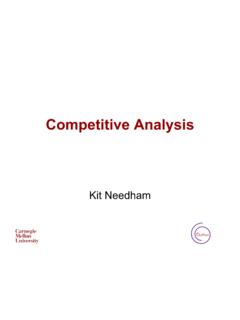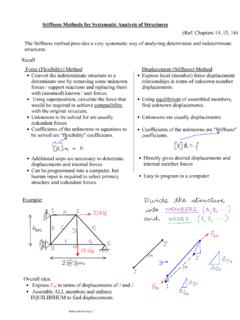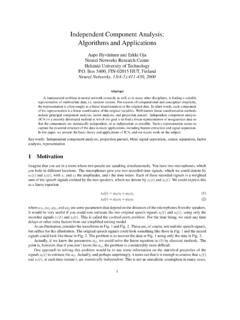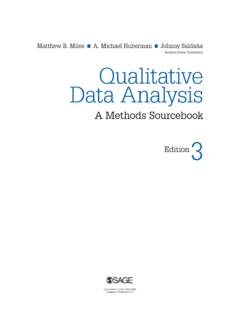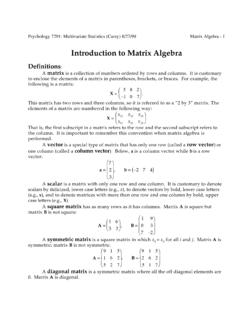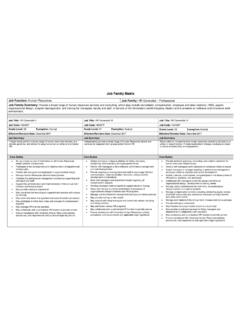Transcription of Analysis of Internal Factor Evaluation Matrix, External ...
1 East African Scholars Journal of Economics, Business and Management Abbreviated Key Title: East African Scholars J Econ Bus Manag ISSN 2617-4464 (Print) | ISSN 2617-7269 (Online) | Published By East African Scholars Publisher, Kenya Volume-2 | Issue-4 | April-2019 | Quick Response Code Journal homepage: Copyright @ 2019: This is an open-access article distributed under the terms of the Creative Commons Attribution license which permits unrestricted use, distribution, and reproduction in any medium for non commercial use (NonCommercial, or CC-BY-NC) provided the original author and source are credited. Article History Received: Accepted: Published: Published By East African Scholars Publisher, Kenya 186 Research Article Analysis of Internal Factor Evaluation matrix , External Factor Evaluation matrix , Threats-Opportunities-Weaknesses-Strengt hs matrix , and Quantitative Strategic Planning matrix on Milk Products and Nutrition Segment of Nestl India Felicia Juliani Leliga1, Janet Devina , Anastasia Cherry 1 Universitas Pelita Harapan Surabaya, Indonesia.
2 *Corresponding Author Felicia Juliani Leliga Abstract: A lot of Indians started moving towards healthy lifestyle. Nestle is one of the largest multinational food companies in India. Most of its income comes from Milk Products and Nutrition (MPN) sales. Nestle has to maintain or even improve the quality of their nutritious products, in order to be able to secure their market share in India. The purpose of this study is to determine the strategic alternatives for this segment. Secondary data such as annual reports, news articles, and Analysis on trusted websites were used to conduct this study. the data was processed by using IFE, EFE, TOWS, and QSPM matrices. This study aims to identify External and Internal indicators affecting MPN sales performance, to present the strategies that could be implemented based on those indicators, and to determine the priority strategy to execute the plan.
3 The result shows that Nestle India should prioritize to apply product development strategy first, then related diversification strategy. Keywords: milk products and nutrition, strategic planning, strategic management, IFE, EFE, TOWS, QSPM. 1. INTRODUCTION More than fifty percent of the global population lives in Asia, with China and India being the most populated countries in the world, each having billion and billion respectively ( ). Nowadays, a lot of people especially millennials started to shift away from meat, and opt for healthier or more nutritious food. When purchasing foods, they take the food source, animal welfare, and environmental impacts into consideration before reaching any decisions ( , 2018). This trend also happens in India, where millennials make up sixty five percent of the population ( ). Not only millennials, people in general who live in urban India like Kolkata, Pune, and Delhi reportedly starting to move towards healthy lifestyle which is shown through their use of fitness application HealthifyMe ( ).
4 The Food Safety and Standards Authority of India (FSSAI) also launched Eat Right Movement which is supported by food companies around the country ( ). Nestle is one of multinational food companies that operate in India. It was established in 1866 and has commitment to improving quality of life and contributing to a healthier future. The headquarter is located in Switzerland, and is one of the largest food and beverage companies in the world ( , 2018). Nestle has sixteen principal markets which are United States, Greater China Region, France, Brazil, United Kingdom, Mexico, Germany, Philippines, Canada, Italy, Japan, Russia, Spain, Australia, India, and Switzerland ( , 2018). In India, Nestle has Milk Products and Nutrition (MPN), Prepared Dishes and Cooking Aids (PDCA), Powdered and Liquid Beverages (PLB), and Confectionery as its product groups ( , 2018). The PDCA products are sold the most in 2018, but the highest income comes from the MPN products sale (see figure 1).
5 As explained above, customers demand towards nutritious foods is increasing each day. Therefore, Nestle has to maintain the quality of their MPN products, considering the threat that comes from Felicia Juliani Leliga et al., East African Scholars J Econ Bus Manag; Vol-2, Iss-4 (April, 2019): 186-191 East African Scholars Publisher, Kenya 187 local competitor, Anand Milk Union Limited (Amul), which is the biggest dairy cooperative and retail chain in India ( ). Figure 1. Details of Product Sales (Nestl India annual report, 2018) Strategic planning is a critical mean to help companies to reach their goals. It is a part and a key to successful strategic management (Gurel, E., & Tat, M. 2017). Studer implies that strategic management is a set of managerial decisions and actions that determine the company s performance over the long term (Widiatama, et al., 2018; Studer, S. 2016). Formulating a good set of strategies will improve the performance sale, vice versa.
6 Hence, SWOT Analysis was conducted to find solutions to maintain the MPN products sales performance. SWOT Analysis is a tool used for building organizational strategy and competitive strategy (Gurel, E., & Tat, M. 2017). It consists of Strengths , Weaknesses , Opportunities , and Threats . Strengths and weaknesses are the Internal factors that can be found from within the company, and opportunities and threats are the External factors that affect the company s performance. After analyzing the SWOT, Internal Factor Evaluation (IFE) matrix , External Factor Evaluation (EFE) matrix , Threats-Opportunities-Weaknesses-Strengt hs (TOWS) matrix , and Quantitative Strategic Planning matrix (QSPM) were conducted to find strategic alternatives for Nestle India s MPN segment. The purposes of this study are to identify External and Internal indicators affecting MPN sales performance, to present the strategies that could be implemented based on those indicators, and to determine the priority strategy to execute the plan.
7 2. Literature Review Internal Factor Evaluation (IFE) and External Factor Evaluation (EFE) matrix IFE and EFE are part of the input stage of strategy-formulation. Making small decisions in the input matrices regarding the relative importance of External and Internal factors allows strategists to more effectively generate and evaluate alternative strategies (David, F. R. 2011). According to David (2011), after listing all the identified Internal and External factors derived from the SWOT Analysis , a weight that ranges from (not important) to (all-important) is assigned to each indicator. The percentage form can also be used instead of the decimal form. The weight is used to measure the importance of a given indicator to the company s industry. And then, ratings from 1-4 should be assigned to represent the value of response, where 1 is major weakness (IFE) or poor response (EFE), 2 is minor weakness (IFE) or average response (EFE), 3 is minor strength (IFE) or above average response (EFE), and 4 is major strength (IFE) or superior response (EFE).
8 Afterward, multiply each indicator s weight by its rating to determine weighted scores for variables. The weighted scores must be summed to get the total weighted scores. (TOWS) matrix TOWS matrix is a part of the matching stage of strategy-formulation. Weihrich states that a lot of experts suggest a company to use its strengths to take advantage of opportunities, but then they ignore other important relationships, such as the challenges of overcoming weaknesses to exploit opportunities (Puri, P. 2017). This matrix was first introduced by him in 1982 by pairing the External factors (threats and opportunities) with the company s Internal factors (weaknesses and strengths) (Weihrich, H. 1982). It consists of four types of strategies which are (David, F. R. 2011): S-O strategies, that use a company s Internal strengths to take advantage of External opportunities, W-O strategies, that aim to improve Internal weaknesses by taking advantage of External opportunities, S-T strategies, that use a company s strengths to avoid or reduce the impact of External threats, and W-T strategies, which are defensive tactics directed at reducing Internal weakness and avoiding External threats.
9 Felicia Juliani Leliga et al., East African Scholars J Econ Bus Manag; Vol-2, Iss-4 (April, 2019): 186-191 East African Scholars Publisher, Kenya 188 Quantitative Strategic Planning matrix (QSPM) QSPM falls within the final stage of strategy-formulation, which is the decision stage. Indicators are derived from the previous Internal and External factors. This is used to determine or rank the best alternative strategies for the business. According to Abratt and also Dibb (in David, et al.,), QSPM determines the relative attractiveness of various strategies based on the extent to which the alternative strategies will enable the firm to capitalize upon strengths and opportunities, improve upon weaknesses, and avoid or mitigate External threats (Abratt, R. 1993; Dibb, S. 1995; David, M. E. 2016). It requires subjective decisions, where making decisions throughout the process increasing the likelihood that the final strategy decision for the organization (Zulkarnain, A.)
10 2019). New additional components for QSPM are Attractiveness Scores (AS), Total Attractiveness Scores (TAS), and the Sum of TAS. 3. RESEARCH METHOD Research Approach The type of data that is used in this study is secondary data, which are annual report, news articles, and writings or Analysis found on trusted websites. Descriptive method was used to present the problems with the aim to find proper strategies for the company. Data Analysis Techniques This study uses three matrices for data processing, which are IFE and EFE matrices (the input stage), TOWS matrix (the matching stage), and QSPM (the decision stage). Final decision was made by using QSPM. 4. RESEARCH FINDINGS The result of IFE Analysis was obtained through a number of indicators of strengths and weaknesses. The ratings in this matrix refer to the strong or weak level of each Factor . The ratings range from 4 to 1, where 4 means a major strength, 3 minor strength, 2 minor weakness and 1 major weakness.

